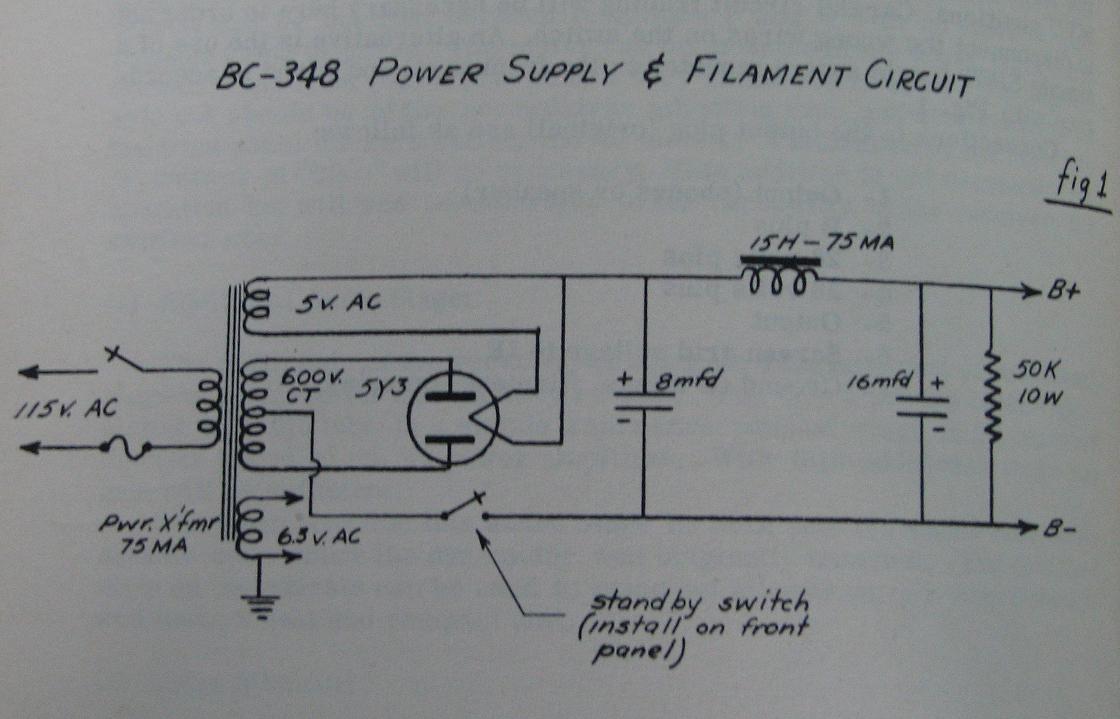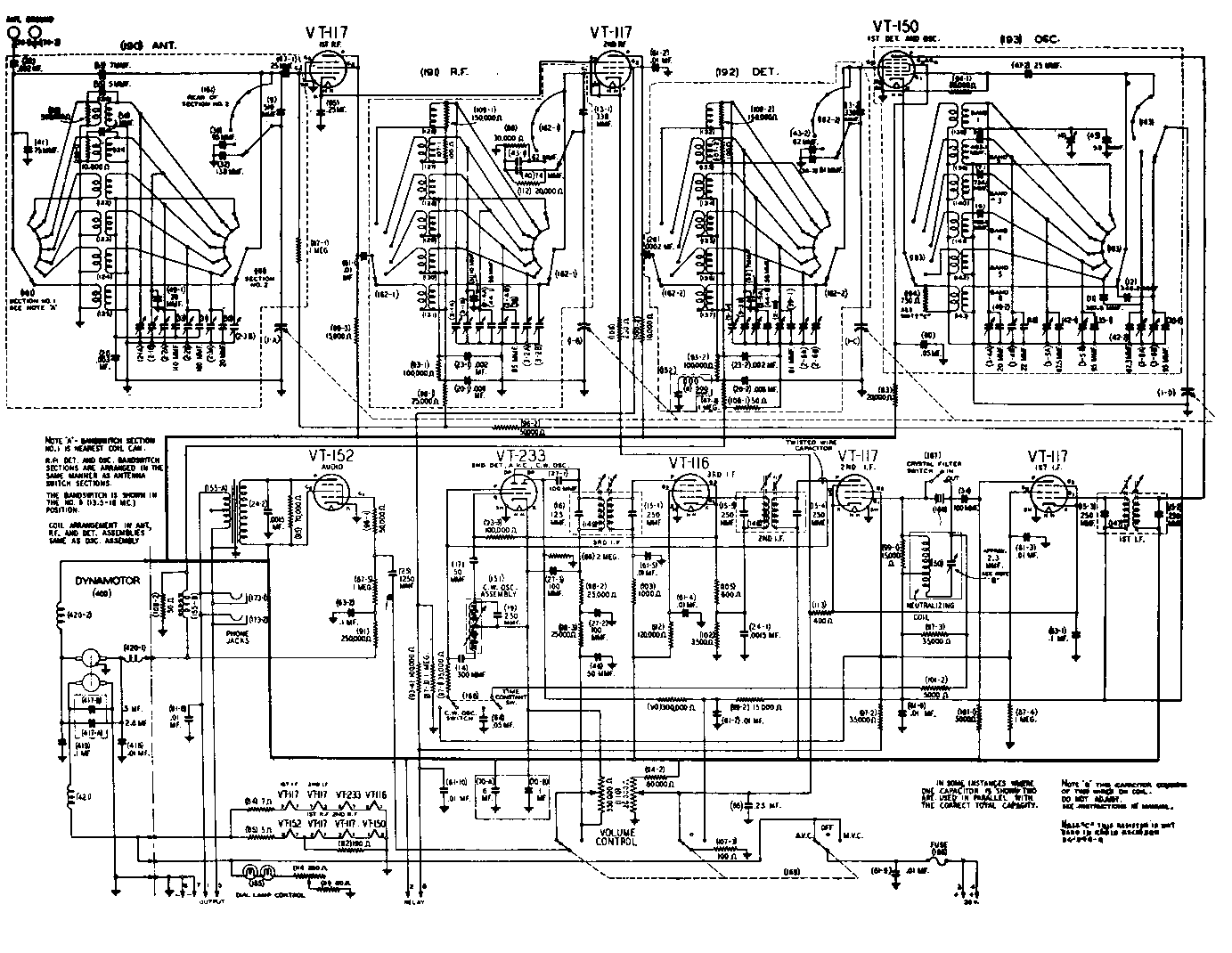BC-348Q Modifications
Warning:
Vacuum tube radios produce potentially lethal voltages! No one should attempt to restore or modify anything without proper knowledge of that working environment. The modifications outline below result in B+ being exposed on the top side of the chasse and this radio must not be operated without the protective cover!
Modifications are always a touchy subject, many collectors feel that the military radios must always be in one hundred percent active duty configuration or that some how degrades them or that they are rare examples of history and must never be changed or used in any other fashion . I am the first to agree that an all original example of a radio should be keep in that condition and lots can be gained from operating it in original configuration, but perhaps some items may have a second life or additional history beyond the military use. In Ham radio the BC-348 may be the second must used item of government surplus, only being surpassed by the ARC-5 series of radios and the history of “Ham” modifications and usage is at least as valuable as its military role.
The first short wave radio I owned was a BC-348 back when I was a teenager in the seventies. Work with that receiver fostered my love of military equipment, helped me develop my skills in electronics where I went on to technical school, college and well paying fields of broadcasting and education. I sold that receiver years ago and although I had owned and restored a couple different BC-348 receivers over the years always longed for the first Ham hacked radio. A couple years back I picked up a BC-348Q receiver at a ham fest, it had holes cut in the face, was missing the dynamotor deck had had many poorly done modifications. I thought this would be a great opportunity to build up not the old BC-348Q I had years ago but what that radio should have been, so I striped the radio down removing all the sub standard work and consulting what I think may be the best guide to modifications CQ 1948 “Surplus Conversion Handbook” set to work on the radio.
There are many published conversion articles on the BC-348, good conversions to hair brain stuff like solid stating the entire radio. Keeping in mind that I did not want to try to build up some strange super radio but wanted to have a good example of what a converted BC-348 should be I settled on only four modifications. The first is conversion for operation from AC power, changing to the audio output stage, a modern coaxial input and finally an S meter circuit.

Copy of the CQ 1948 Power Supply
I did not use the 5Y3 tube but did use a 6X4, I have an almost endless supply of 6X4 tubes and wanted to use a tube instead of solid state diodes to get the delay a tube gives you before applying B+ to the set and get the added advantage of the voltage drop across the tube. The lower the B+ the better, you don’t want to be beating sixty year old radios with excessive voltage.
It’s important to remember to include the original dropping resistor between B- and ground, this helps develop the bias for the receiver. If you can use the original terminal strip from the dyno deck this will allow you to keep B- isolated. The huge electrolytic capacitor for the radio still tested good so I keep it in the set although the first capacitor on the choke input to the power supply is only a fraction of the size and has more capacity.
The filament circuit was wired for 28 volts, the new power transformer supplies 250 volts for the plate supply and 6.3 volts for the filament string. all the tubes are 6 volt tubes so you have to modify the filament string for 6 volt operation.
The original audio output transformer was a dual impedance affair with the lowest impedance being 300 ohms. If you only want to use headphones you can get high impedance headphones and use them. This radio was missing the transformer when I bought it so I decided to use an output transformer from an old RCA television (CTC-28) it’s mounted on a metal plate along with a bypass capacitor from B+ to ground. You can never have too much filtering and now the radio works well with a regular 4 ohm speaker.
The original antenna and ground binding post were missing so after a little work with a 5/8 punch I mounted a coaxial connector on the front panel. The radio is not 50 ohm input but with all the noise sources in the shop a coaxial connection is way better than the original binding post.
Copy of the CQ 1948 S Meter circuit

Copy of the BC-348Q schematic
Someone had tried installing an S meter before and did a bad job of it. I removed their mess and installed this circuit. The back of the meter can be seen up front of the radio with the zero set control mounted next to it. If you do this remember to cover the bare connections because they have high voltage on them.
In conclusion I would like to say that I find this radio a pleasure to use for foreign broadcast or checking WWV or CHU and have on occasion used it on 40 and 80 meter for AM operation, and yes you can go crazy with building in lots more modifications to improve performance but what's the point? Regardless of what you do it will never match a modern receiver's performance on CW or side band but I feel this radio with a minimum of good modifications provides a fun project and a great radio to use just for the enjoyment of it.
The above items were in part taken from the CQ Surplus Conversion Manual Volume 2 released in 1948; any work you may choose to attempt or conversions you pursue are your responsibility and are not approved or warranted by me in any way.
Ray Fantini
BC-348 Video This is a video on YouTube of the same receiver
June 2009